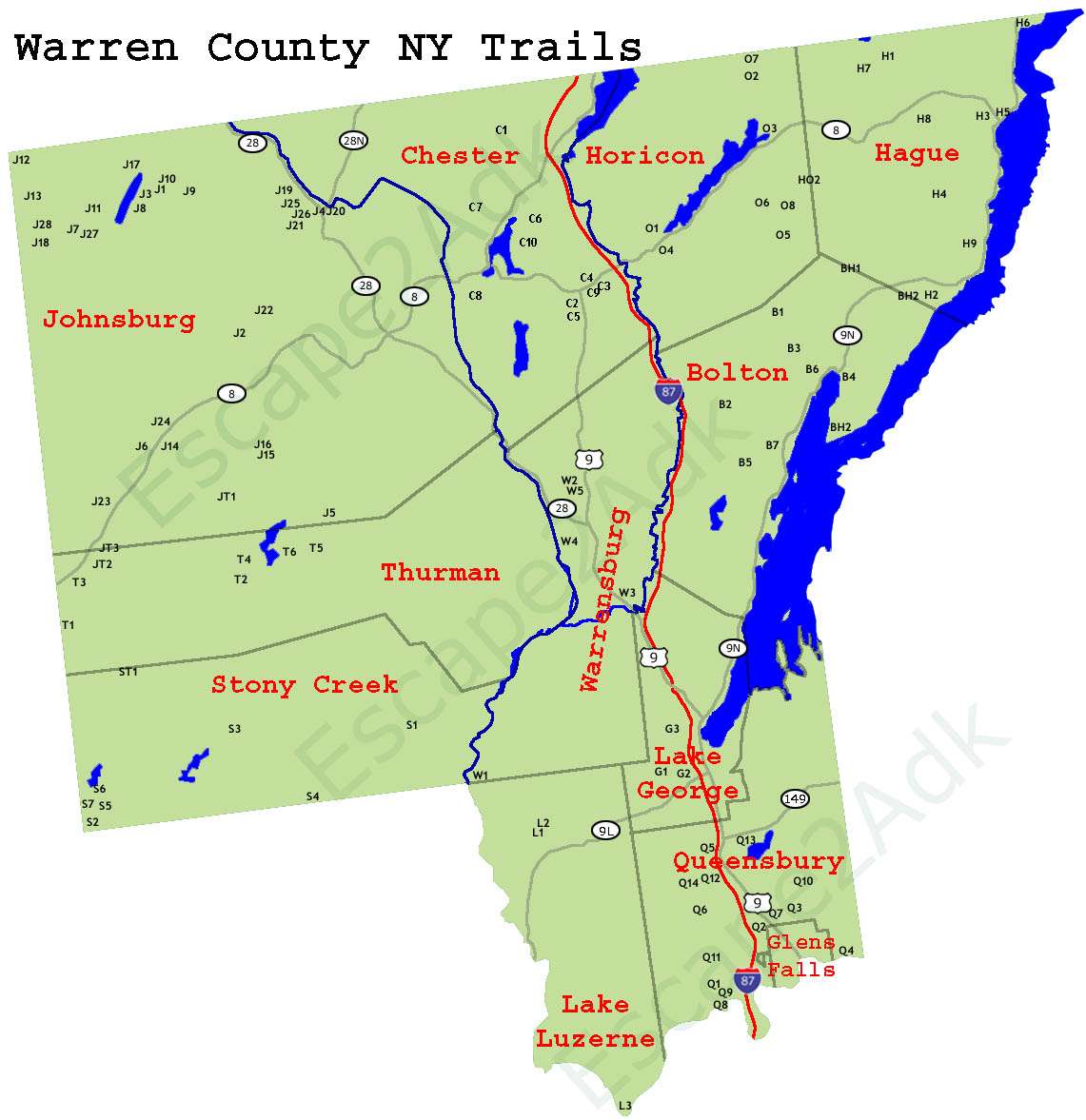Best Hikes Near Lake George, North Creek, and Chestertown NY
 Warren County, nestled in the southeast corner of the Adirondacks, is a hiker’s paradise with a rich tapestry of trails that wind through pristine forests, along tranquil lakes, and up challenging peaks. Whether you are an experienced hiker seeking a strenuous climb or a family looking for a leisurely nature walk, Warren County has something for everyone.
Warren County, nestled in the southeast corner of the Adirondacks, is a hiker’s paradise with a rich tapestry of trails that wind through pristine forests, along tranquil lakes, and up challenging peaks. Whether you are an experienced hiker seeking a strenuous climb or a family looking for a leisurely nature walk, Warren County has something for everyone.
This guide currently links to the best trails in the towns of Bolton, Chester, Hague, Horicon, Johnsburg, Lake Luzerne, Stony Creek, Thurman, and Warrensburg NY. We will be adding trails for Lake George and Queensbury as soon as possible.
Hiking Trails By Town
Click on a link to see a list of all trails in that town.
Bolton (Bolton Landing)
Chester (Chestertown, Pottersville, Riparius)
Hague (Silver Bay)
Horicon (Adirondack, Brant Lake)
Johnsburg (Bakers Mills, North Creek, North River, the Glen, Wevertown)
Lake George
Lake Luzerne
Queensbury
Stony Creek
Thurman (Athol)
Warrensburg
Individual Trails
Click on a link below the map to see information about an individual trail.

Here are some essential safety tips, recommended gear, and precautions. We’ll also touch on some of the benefits of exploring this beautiful region on foot.
Safety and Preparation
1. Know Your Route
Before heading out, familiarize yourself with the trail. Research trail conditions, estimated time, and difficulty level. Carry a map, and if possible, download offline maps on your phone. The Adirondacks can have limited cell service, so being prepared with a physical map is crucial.
2. Charge Your Phone
Make sure your phone is fully charged before leaving for your hike. This is essential if you are referencing an offline map on your phone and may be critical if you have an emergency. Load your phone with the DEC Dispatch phone number: 1-833-697-7264.
3. Check the Weather
Weather in the Adirondacks can change rapidly, especially at higher elevations, and frequently varies from town to town. Even a quarter mile can make a huge difference. Check the forecast before your hike. The National Weather Service has a Mountain Point Forecast web page showing information in three-hour windows including temperature, wind, sky cover, precipitation, heat index, lightning risk, and snow amounts.
While it may be perfectly clear where you are, the next valley over may be experiencing rain or even tornadoes. Be prepared for quick change from hour to hour with plans and gear to take into account rain, wind, or sudden drops in temperature. In the fall or spring a temperature drop can mean a rapid change from rain to snow and ice so make sure you have the appropriate clothing and footwear. At any time of year a windstorm can drop trees and branches, possibly causing injury or delaying your trip to detour around fallen trees.
It’s also a good idea to be aware of any danger from forest fires. Visit the New York State Fire Danger page to learn more.
You can also look up the water levels for streams at the Real-Time USGC Statewide Streamflow website.
4. Tell Someone Your Plans
Always inform a responsible friend or family member of your hiking plans, including your expected return time. In case of an emergency, this information can be vital. Better yet, also buddy up: hike with a friend or group of friends so you have someone to help watch your back. When you get back from your hike, let anyone you told know that you have returned.
5. Start Early
Begin your hike early in the day to allow plenty of daylight for your return. Even experienced hikers can take longer than expected, so give yourself ample time to complete the hike, particularly if you do not know the trail conditions for your trail(s) or if this is a new trail for you.
Gear and Equipment
1. Footwear
Wear sturdy, comfortable, broken-in hiking boots or shoes with good ankle support. Trails in Warren County can be rocky and uneven, so proper footwear is essential to prevent injury. In the winter wear boots with crampons or snowshoes.
2. Clothing
Dress in layers, as temperatures can vary throughout the day. Even in summer, mornings and evenings can be cool. Moisture-wicking base layers, insulating mid-layers, and a waterproof outer layer are recommended. A hat, gloves, and a waterproof jacket are great ideas, and in the winter bring wool socks, extra thermal undergarments, and a face mask.
3. Navigation
Carry a map and compass, and consider bringing a GPS device. A fully charged phone with a portable charger is also recommended, but don’t rely solely on it, particularly since cell service e is unreliable or unavailable in most locations. Coverage can also vary widely depending on the carrier and service plans. Bring extra batteries.
4. First Aid Kit
A basic first aid kit should include bandages, antiseptic wipes, blister treatment, and any personal medications.
5. Food and Water
- Bring plenty of water and high-energy (high protein and high calorie) snacks.
- Bring extra food.
- Pack at least two liters of water each. A water filter or purification system is recommended for longer hikes.
- Insulate your water and food in the winter and pack the food near the center of your pack to help prevent freezing.
6. Emergency Gear
Carry matches, a fire-starter, and/or a lighter. Also bring a flashlight with extra batteries, and a multi-tool. A space blanket or emergency shelter like a tent or a tarp can be lifesaving in unexpected situations.
7. Check the Season
Most of the trails in Warren County cross areas where hunters may be active during hunting season and many trails are closed during hunting season. There are several hunting seasons, from big-game seasons for bear and deer to small game and waterfowl seasons, and there are also several types of seasons, such as muzzle loader, bow, crossbow, and hunting rifle seasons. Big game seasons tend to start in September and run into December, but always check to see if the hike you plan on might be in an active hunting area, particularly during big game season. Dress appropriately with bright orange, red, or neon colors and always be aware of what is around you during your hike. Click here to see an infographic with NY hunting seasons and maps.
Precautions
1. Sign the Register
Make sure to enter the date and time. This will help searchers if you become lost or injured. As a courtesy, sign out again when you leave.
2. Wildlife
The Adirondacks are home to bear, moose, and other wildlife.
Make noise while hiking to avoid surprising animals, and store food properly to avoid attracting bears. New York State requires the use of bear canisters for storing food when camping in the Adirondacks. If you encounter a bear, do not run. Instead, make yourself look larger and back away slowly.
If you encounter a rattlesnake, freeze in place until you or a companion can locate it. If you identify it from a distance, leave it alone and keep away. One third of bites occur when someone tries to handle or kill the snake.
Do NOT wear earbuds in both ears. Earbuds may prevent you from hearing a warning Whuff! from a bear or a rattle from a snake.
Encounters with wildlife may be far more likely at dawn and dusk.
3. Conserve Your Phone
Turn off your phone or switch to Airplane mode to conserve the battery. If you need a light, use a flashlight or headlamp.
4. Track the Time
Note what time you started your hike so that you can accurately estimate when to return.
5. Trail Etiquette
- Follow Leave No Trace principles: pack out all trash
- Stay on designated trails. Walking off-trail can harm sensitive and rare plant species. Many trails cross private land via easements. Please respect these lands and do not leave the trail. Failure to do so may result in the loss of the easement.
- Respect wildlife.
- Give uphill hikers the right of way and be courteous to others on the trail.
- Park in designated parking areas only. Parking elsewhere may result in traffic problems and risks to hikers.
- Do not use waste disposal cans to clean out your vehicle. Many hikers use these trails and if the trash cans are full people may choose instead to drop items along the trail.
Drones
Use of drones on Forest Preserve lands is prohibited in areas classified as Wilderness, Primitive, Primitive Bicycle Corridors, or Canoe Areas.
Hobbyist use is allowed only with an approved Temporary Revocable Permit (TRP), on lands classified as Wild Forest.
Benefits of Hiking in Warren County
1. Physical Health
Hiking is an excellent cardiovascular workout, improving heart health, muscle strength, and endurance. The varied terrain in Warren County provides both moderate and challenging hikes that cater to different fitness levels.
Most trails are wilderness trails. There may be roots, stones, mud, stream crossings, cable crossings, and other hazards Due to the wide variance in surfaces and tools, hikers must often use a much wider variety of muscles than they would normally need for a simple paved or gravel trail, resulting in a much more balance workout.
2. Mental Well-being
Spending time in nature has been shown to reduce stress, improve mood, and enhance mental clarity. The peaceful surroundings of the Adirondacks offer a perfect escape from the hustle and bustle of daily life. Gain the most benefit from this by turning off music, phones, and other devices.
Enjoying breathtaking views can be great, but everyone appreciates different things. Enjoy the moment. It’s about appreciating the day, not about topping what you saw the day before.
3. Connection to Nature
Hiking in Warren County allows you to connect with the natural world, offering opportunities to observe wildlife, enjoy the changing seasons, and appreciate the beauty of the Adirondack landscape.
4. Wildlife
Enjoy all of the wildlife, not just the big mammals. Red efts (the immature Eastern Newt) can be found throughout much of the forest during the early-to-mid-summer. These cute little bright amphibians can really stand out once you notice them, and in some places they can be so common that it can be hard to avoid stepping on them. Tree-frogs can also be very common, as well as red and gray squirrels and chipmunks. Painted turtles are often seen sunning themselves along fallen logs stick up out of ponds and flows, and songbirds can be heard through much of the forest.
Seasonal Information
Spring
Springtime in the Adirondacks brings blooming wildflowers and flowing streams. However, trails can be muddy, and later in the spring black flies are common. Wearing long sleeves and insect repellent is advisable.
Summer

Summer is the most popular season for hiking, with warm temperatures and long daylight hours. Trails can be busy, so starting early helps avoid others at some of the most popular trails. Be prepared for thunderstorms and carry plenty of water. Insect repellent continues to be an essential; black flies continue to be an annoyance and are joined by mosquitoes, deer flies, and later in the season add no-see-ums to the list.

Fall
Autumn offers stunning foliage, cooler temperatures, and few if any bugs. It’s an ideal time for hiking, but be prepared for shorter days and chilly mornings and evenings.

Winter
Winter hiking in the Adirondacks requires special preparation. Trails can be icy or snow-covered, so traction devices like microspikes or snowshoes are necessary. Waterproof insulated boots are necessary once snow is present. Dress in warm layers, do not over-exert (sweating is dangerous) and be aware of shorter daylight hours. Be aware that difficulty levels can dramatically harder in extreme cold and snow.
Conclusion
Hiking in Warren County offers a rewarding experience for all levels of outdoor enthusiasts. With proper preparation, the right gear, and an understanding of the trails and conditions, you can safely enjoy the natural beauty of the Adirondacks. Whether you’re seeking solitude in the wilderness or a family adventure, the trails of Warren County await your exploration.